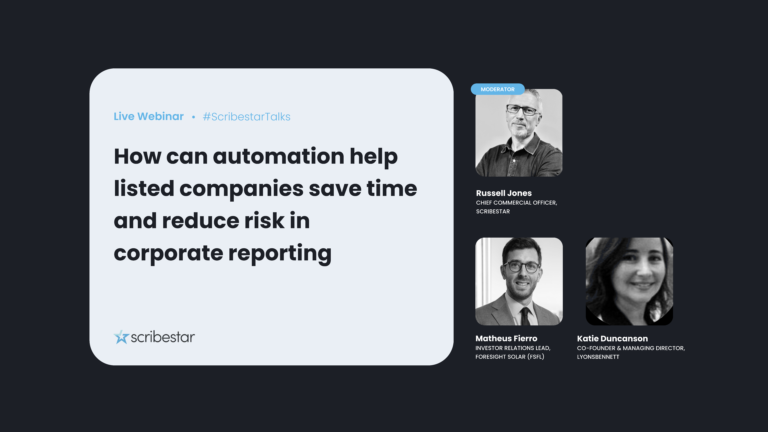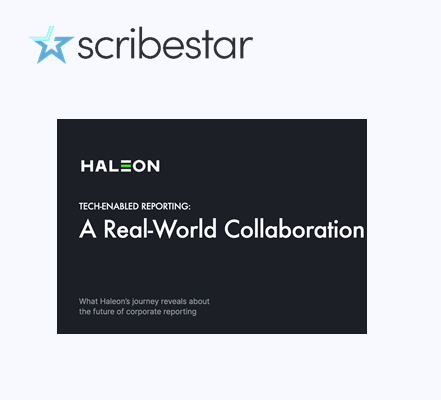ScribeStar Co-Founder and Executive Chairman Adam Shaw participated today in the Europeanissuers webinar on the Digitalisation of EU Capital Markets to discuss technology and market trends in the capital markets space. He was joined by Peter Kerstens, Adviser on Technology and Innovation at DG FISMA, Friedrich Luithlen Global Head of Debt Capital Markets at DZ Bank, Hervé Labbé, CEO of NowCP, and Robert Koller, the Executive Chairman of the european primary placement facility (eppf).
The event came at a time when Europe is making strong strides towards a Capital Markets Union, and the market is rapidly adjusting to accommodate COVID19 induced demands for quick and efficient access to capital and for new ways of remote capital markets operations. It was an exciting panel of technology providers, bankers, and policy makers, each with a unique perspective on the role of digitalisation in this respect, and what the European capital market of the future looks like. Below are just some of our takeaways from the discussion.
- THE BIG TECH TRENDS:There are five notable technology trends driving innovation and change in the capital markets space. These are cloud computing, APIs, Big Data and analytics, Process Automation, and finally DLT, blockchain, crypto, and tokenization. Demand driven market transformation will also inspire regulatory change, but also induce a quicker tech adoption curve on the side of market participants and regulators.
- LISTING PROCESS AND COSTS FOR SMEs: Though there is still strong demand for innovation on the trading and settlement side, technology advancements on the non-trading side have been slower. This is primarily in respect to documentation production and process management associated with bringing companies and transactions to market, and keeping them compliant with market regulations. For an SME a cost of an IPO can reach up to 15% of the value of the issuance, while regulatory burdens and costs associated with ongoing compliance are often mentioned by managers as some of the most laborious and costly business processes.
- DIGITAL CAPITAL MARKETS ECOSYSTEM: In order to have a truly seamless issuance process, whether that’s via an independent bond or equity trading platforms or via an established stock exchanges, we have to create a digital environment where the pre-issuance documentation creation and compliance process is integrated with the trading side and linked with automated ongoing compliance. ScribeStar does that by bringing together multiple dislocated market participants to create and manage transaction documentation and process in a secure regulatory compliant digital environment. ScribeStar creates documents in structured data format, allowing for such level of automation and data utilization by the platforms and investors, regardless of the type of security, marketplace, or location.
- THE ROLE OF STOCK EXCHANGES: To demonstrate this, we’ve mentioned our work with Aquis, a dynamic growth market in the UK, where we are redefining the standards of what an issuance process looks like, how much it costs, and how long it takes. By working together with the regulators, and by placing the issuance and compliance process on a digital platform, in an automated and templated way, issuers will be offered with a simple and efficient listing process, and thus cheaper and easier way to access the market and stay there.
- REGULATIONS AND WHY WE NEED THEM: Regulations inflate post-crisis, and deflate in times when the economy needs a stronger boost. It is a cyclical process. There is an ongoing debate to reduce regulatory diversity at an EU level, but there are also decisions to be made in terms of the intensity of those regulations. It is a balancing act which has to be approached carefully, and considered in respect of EU capital markets harmonization as well as how it impacts on market participants. Ultimately, regulations are there to protect investors and the market as a whole. Technology is therefore a way of easing compliance with appropriate levels of regulation rather than reducing the levels of regulation. By automating and digitising regulatory processes, the associated time consumption and costs for complying can be reduced. Embracing digitalisation also helps regulators and policy makers to better understand regulatory impacts and make better educated decisions.
- SUPPORT FOR INNOVATORS: If it doesn’t want to be left behind, Europe has to nurture and support innovation, and help build a strong technology infrastructure. We have to secure risk capital to help companies innovate and grow, and give them a playground where their technology can be tried and tested. For that purpose, sandboxes and a good safe environment to experiment in, while also allowing regulators and supervisors to learn directly from the innovators.
- BOND TRADING PLATFORMS:Taking bond markets as an example, innovation will mostly be driven by large issuers who have identified shortcoming in the process, that being placement and allocation, documentation, settlement, underwriting, advice, or validation of decisions made by the issuers. From the current perspective there is a strong case to be made for platforms to address the issue of documentation, some aspects of trading, placement and allocation. We should also note that many liquidity bond trading platforms are natural monopolies. Whether that’s ok is a question for the market and policy makers. An example of such a question would be whether the dealers and the issuers would want independent bond platforms monopolising data that they would like to have access to.
- EQUITY MARKETS:In respect of the equity market, especially SMEs, there is not a single solution that would fit in the same way as for bonds given the bespoke nature of each issuance and the fact that all of the current issuance processes are static and do not allow the use of structured data. Everyone agrees that SMEs have to have a clearer and easier path to market. Currently there are too many legal and compliance costs involved with that process. By creating a digital environment where structured data can be used for equity markets will allow automation, which will a significant positive impact for the market as a whole and in particular for SMEs. Automation will also allow for things to be better standardised, in line with the CMU HLF action points, and data will allow investors to be able to compare and understand investment opportunities quicker. Simpler analysis would drive more investments in SMEs, and more companies to market. Furthemore, enabling the issuers to work together with their deal teams, the exchange, the regulators and the market in a digital online manner will obviate the relevance of location and proximity.
The future looks bright, and there are many promising technology initiatives which will drive positive change. The only way forward is for the industry, technology providers, regulators and policy makers to work together. We enjoyed exactly such an experience in today’s panel. Many thanks to our panellist colleagues for the engaging discussion, all the participants for tuning in, and EuropeanIssuers for organising. We’re looking forward to the next one!



